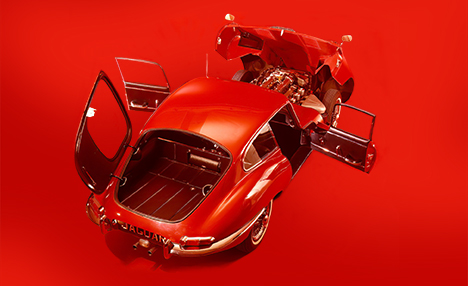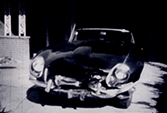(This year we celebrate the 100th anniversary of the birth of Donald Mitchell Healey, and as such, we would like to present an interview with him which Paul Chudecki undertook in 1986, and which gives an insight into the man responsible for those magnificent machines. Paul traveled down to Perranporth, Cornwall, to interview Donald just before his 88th birthday on July 3. Here is part one!—Ed.)
During the past four-and-a-half decades, there have been few affordable British sports cars that have stirred the imagination of drivers and enthusiasts alike as much as the Austin-Healey. Indeed, the very term “Big Healey” conjures up images of red and white beasts barreling through forests or across race trucks on opposite lock, engines bellowing mightily. But that is just the competitive edge. Austin-Healeys, whether 100, 3000 series, or the diminutive Sprite, have given much pleasure as sporting road cars.
But what of the man who gave his name to these cars? Donald Healey sat in his home with me and talked about the old and glorious days, his favorite cars, and his thoughts on motoring past and present. Born in Perranporth in 1898, his father was responsible for having built the local shopping center and golf course. Healey left school when WWI broke out.
“My father was very sporting,” Healey recalled, whose friendly face and smiling eyes hint at a mischievous past. “He let me do night schooling in Kingston and then I went to Sopwith’s, famous for the Schneider Trophy. They made some wonderful airplanes.”
Donald Healey was at Sopwith when they designed the Camel, but it was a career in the motor industry that he was to pursue. Ironically, it was his Aviator’s Certificate that he obtained first in 1916. His driver’s license did not follow until four years later! During the Great War, Healey was initially posted with the Royal Flying Corps on home and Zeppelin defense. In 1917, while flying over France in an TF2B, he crashed and was subsequently invalided out of military service. He lightly recalled that there was not much damage to either himself or the plane!
From the RFC, he moved to the Aeronautical Inspection Department covering the west of England, where he remembered with affection Harry Hawker of Hawker Engineering and manufacturer of the famous Hurricane fighter. “Harry once flew under the bridge at Brooklands! He was a wonderful pilot and a great chap,” added Healey, his eyes grinning at the memory.
Donald Healey moved back to Perranporth around 1920, where he started a small garage business under his own name while also manufacturing radios under the name of Perraphone, having studied wireless technology. He recalled, “The first car I ever worked on was a one-cylinder Rover, and I soon got on to driving smaller cars in competition.” Among these were ABC, Riley, and Triumph, before a works 4 1/2-liter Invicta arrived on the scene. Its supercharged engine took Healey to several successes, including the Monte Carlo Rally of 1931. (This car, incidentally, was courtesy of Sir Noel Macklin, whose son Lance was to make a name for himself in later years driving for Healey.)
“A few other successes followed,” Healey added modestly, “a second overall in a small Triumph, then a third, which got me the Perpetual Trophy, one of the few I’ve kept, and awarded to the driver in the first three places.”
In 1933, Healey was employed by Triumph as an Experimental Manager but within the year he was promoted Technical Director. It was while he was there that the fabulous straight-eight Triumph Dolomite was born, basically a crib of a famous Italian marque. “I make no bones about it,” continued Healey, “it was a copy of the Alfa Romeo. All those stories about the Italians suing us are rubbish, though we did discuss the Triumph/Alfa name. At the time there was a great cry for a new British sportscar. Without the supercharged motor it was not so fast, but I went to the Gulf of Finland in it, and it went alright.”
Healey stayed with Triumph until the outbreak of WWII, when the company went broke and the factory was sold. He, however, stayed on at the factory, making carburetors for the aircraft industry. “I worked with Pomeroy Senior [sic] and we invented a system of blowing petrol through at the same speed as suction, so that we could get exact measurement of fuel consumption without actually putting the carburetor on an engine!”
During WWII, Healey was with the Air Training Corps as a Squadron Leader, still finding time “to fit in some armored car research work at Humber’s, where I met those two young chaps (Sammy Sampietro and Ben Bowden) that did the design work on the first Healey in 1945. The tracing was done by the WAF girls at Honiley airport!
“I was a great friend of Victor Riley and I went to Riley’s to prepare the team cars for the Alpine Rally in 1932. I knew Victor from the early days at Perranporth when I had a Red Winger Riley—so the first Healey had a Riley 2 1/2-liter engine. One of my best successes was the [Circuit of Ireland International Rally] 10,000 kms, the longest rally held in Europe during 1931, in a six-cylinder Riley. The Riley was a damned fine car. I was sorry when it was modernized by Morris and mined.” Healey looked thoughtful as he digressed for a moment, but the sparkle soon returned.
“I was extremely lucky to get those engines, because in those days you had to have a permit to make cars. Unfortunately, Riley had engines tucked away and we had one to 10 a week.
“The ordinary Healey was the first car we took to America, then we made up the Nash Healey when the Riley engine packed up. They nearly all went to America, and Briggs Cunningham was one of the best customers. We put a Cadillac motor in it for him. It goes like a bomb and is highly dangerous,” Healey laughed, having sampled the beast on a recent visit to the States.
“We had a good run with the Nash Healey, but at too high a price, because we had to ship the engines and gear boxes over. It was really beautiful with the Farina body. The Nash Healey was very successful at Le Mans, driven by Wisdom and Johnson; it came third one year behind two Mercedes and fifth another year driven by Roll and Hamilton.”
To most enthusiasts, the Healey name is famous for the Big Healey revered by many as the last of the British muscle sportscars. The history goes that the design was quickly snapped up by Austin after the model debuted as the Healey 100 at the 1952 Motor Show in Earls Court, but Healey admits that at the time he wasn’t very pleased with it.
“Gerry Coker (ex-Humber) designed the body and was not very happy with it, so we put the nose against the pillar to hide the disappointing radiator shape. Then Len Lord brought Nuffield along, and there was also another chap from Hudson Motors interested. Subsequently over several dry Martinis at the Hyde Park Hotel with Len Lord, a deal was struck and a contract signed overnight. The Austin-Healey was born.
“Len was very good; he’d just had a bad experience with a beautiful Gruber prototype that was ruined into becoming the Atlantic. He let me have some units, taxi cab engines and gearboxes, and put an order out not to alter a single line drawing without our permission. He let us keep the design right so it wasn’t mined like the Graber, and overnight we changed the badge too.”
(There is no need to detail the ensuing history and development of the Austin-Healey. The model names say it all: 100, 100S, 100M, through to the six-cylinder 100/6 and 3000 models—not forgetting, of course, the Frogeye and later Sprites.)
“The 100/6 was my idea. U.S. sales were slowing up, so we put in an imitation seat for the family, so that it would appeal to a wider market, and it did. We never could make enough sixes. After Austin decided to discontinue the Healeys, one Philadelphia dealer ordered 2,000, and so they put them back on the production line!
“They must have made a lot of money out of Healeys.” The remark was followed by a rueful smile. “They never broke or gave any trouble at all, and I think that’s why they’re working so well today—they never work hard, stress is low. Rust was the killer. No mutter how much protection there is on the frame, it always rusts on the inside.”
It is fair to say that Donald Healey does not have fond memories of the final days of the Healey/Austin union under Lord Stokes—very much a Triumph man. “I was so disgusted with Stokes and what he did to the British sports car. He told me, ‘I’m not going to have any more extraneous names, I’m going to have a proper sports car made by MY engineers—no more Coopers, Healeys, or Gs!’ Triumph was a failure and so was he! I was so disgusted I sold all the Healey spares to a storekeeper for under £3,000, and he’s now retired to Italy!”
(This article first appeared in Sporting Cars International and is used with permission.—Ed.)







'Donald Healey on Healey, Pt. I' has no comments
Be the first to comment this post!